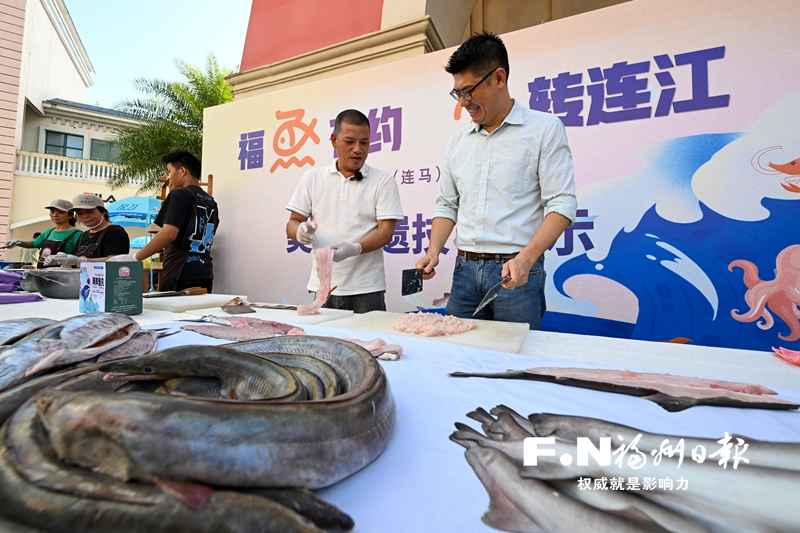"Cross-straits Fish Balls" Debut in Fuzhou
At the 2023 Fuzhou (Lianjiang- Matsu) Fish Ball Cultural Festival held on the 27th, Fuzhou’s "cross-straits fish balls," the first of its kind, made a debut, marking their official entry into the market. This means that the flavor of hometown on both sides of the Taiwan Straits will be spread around the world in the form of commodities, and included into the "Urban Life Circle" of Fuma, adding a strong brush for the demonstration area construction for the integrated development across the Taiwan Straits.

Representatives from both sides of the Taiwan Straits were making "cross-straits fish balls." (Photo / Reporter Chi Yuan)
Lianjiang County is the closest place on the Chinese mainland to Matsu Island. Huangqi, Lianjiang was called Lishan in ancient times, and Matsu was called Waishan. The shortest distance between the two places is only 4.8 nautical miles. As the birthplace and main producing area of Fuzhou fish balls, Lianjiang has made the achievement that "One out of every four fish balls across China comes from Lianjiang," thus known as "Home to Fish Balls in China."
It’s a cooperation that went down in history. In the exhibition area of intangible cultural heritage skills, Lin Yu, the inheritor of Lianjiang Huangqi fish ball making skills of Fuzhou municipal-level intangible cultural heritage project, and Cao Weihan, a native of Matsu, showed the fish ball making skills of the two places, and jointly launched "cross-straits fish balls," the first of its kind in Fuzhou, marking the formal industrial production and market-oriented operation of the product.
According to the reporter, half of the "cross-straits fish balls" are Huangqi fish balls and half are Matsu fish balls. The packaging is printed with the words "Fuzhou fish balls, a flavor of home, one family on both sides" and "Handmade by inheritors of the fish ball making skills of intangible cultural heritage on both sides," as well as the pictures of landmark lighthouses on both sides of the Straits, thalasseus bernsteini, waves and beaches.
“The promise made four years ago has finally been fulfilled. The two sides of the Taiwan Straits are linked together by intangible cultural heritage again!” On the 27th, Lin Yu and Cao Weihan excitedly shared their joy. It is said that fish balls are a common food on both sides of the straits, representing the people's yearning for their hometown, also known as blessing balls. The "fish" (yu, in Chinse) means "to have abundance year after year;" and "ball" (wan, in Chinese) sounds like the word "yuan" in Fuzhou dialect which means "reunion." It is an indispensable delicacy on the table during festivals.
In 2019, Lin Yu and Cao Changbin, a native of Matsu, were selected as the inheritors of the fourth batch of intangible cultural heritage projects in Fuzhou (Lianjiang Huangqi fish ball making skills). They thus started their cooperation.
As a route for the people on both sides to strengthen their family ties and improve the people's livelihood, the passenger route of the “Mini Three Links” ferry services that connects Huangqi, Lianjiang and Baisha, Matsu resumed at the beginning of this year. "It is the golden time to develop the cross-straits fish ball industry!" After consideration, Lin Yu and Cao Changbin decided to launch a type of fish balls featuring "one fish, two different dishes," so that consumers can taste fish balls from both sides of the Straits with a single purchase.
The outer packaging of the cross-straits fish balls was designed by Cao Changbin's son, Cao Weihan. "The two iconic lighthouses on the packaging illuminate the way home and warm the hearts of the people on both sides of the straits. It was the same idea that we had at the beginning of design," said Lin Yu.
Of the cross-straits fish balls, Huangqi fish balls are made of fresh eel and shark, while Matsu fish balls are made of fresh mackerel. With a gentle bite, you can enjoy a fresh, savory and juicy taste.
Selecting fish, cutting fish, chopping fish, making fish paste, scooping fish balls, boiling fish balls … On the 27th, Cao Weihan, who inherited his father's skills, never slacked off. He worked with Lin Yu to present the whole process of fish ball making "from a fish to a ball" in front of the audience at the event.
"I had the food that bears the flavor of home again. It is a flavor of mom. It represents the eternal yearning for home!" After finishing his work, Cao Weihan ate several fish balls. The last time I ate fish balls was the May Day holiday this year. I went back to Matsu, and my mother made fish balls for me personally. He said, "Lianjiang is the root of Matsu fish balls. Fish balls are our common wealth which should be passed on and carried forward from generation to generation."
On the 27th, the "Lianjiang Huangqi Fish Ball Making Skills" inheritance demonstration base was established in Kuilongfang Cultural Block, Lianjiang. "We will make continuous efforts to actively apply for the provincial inheritor of intangible cultural heritage, build fish ball tourism factories, carry forward the most authentic fish ball making skills on both sides of the Straits through interaction, and promote Fuzhou fish balls to the world." Lin Yu and Cao Changbin had the same idea again.
As the Mid-Autumn Festival is coming, the full moon will arouse people's yearning for reunion. Cao Weihan plans to go back to Matsu this Mid-Autumn Festival to get together with his family and share what he saw and thought at the Fish Ball Festival with them. The cooperation between Lianjiang and Matsu and the collision between Matsu fish balls and Lianjiang's technology bring about savory and delicious fish balls. Perhaps this is the flavor of "one family on both sides." (Reporter Lin Wenjing)